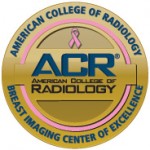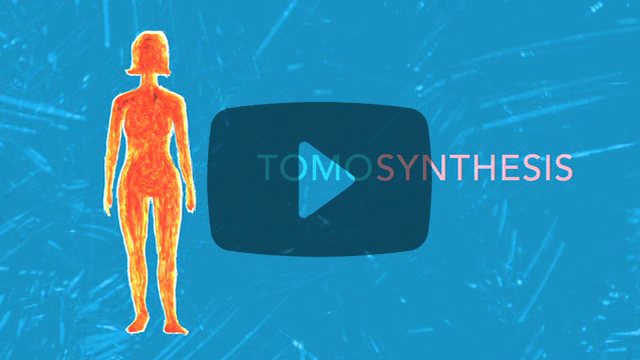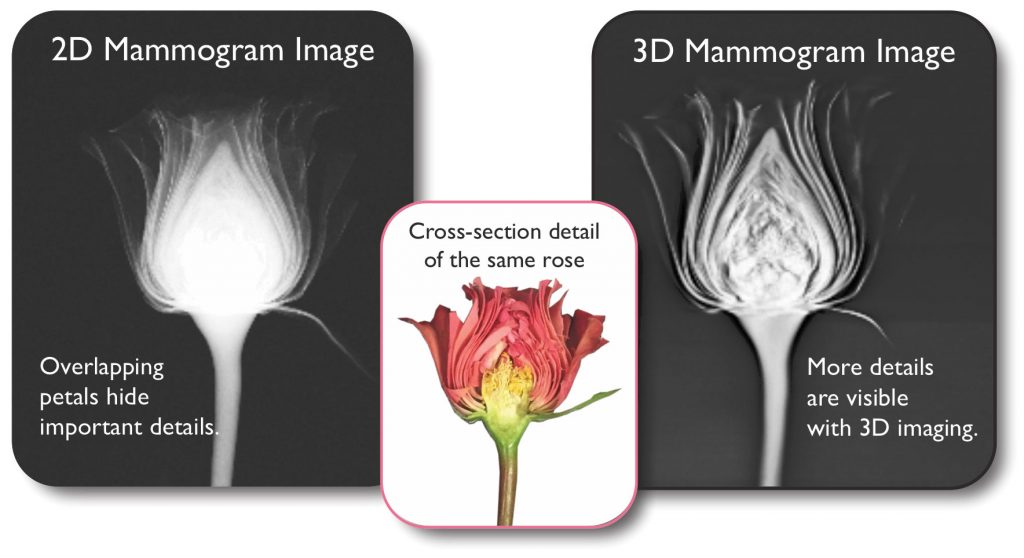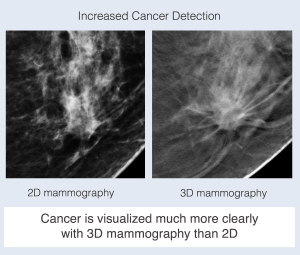Annual Screening
Mammography
Wake Radiology is the Triangle leader in 3D + AI mammography and consistently accredited by the American College of Radiology.
Breast cancer is the most common cancer in women worldwide. A mammogram can detect cancer early, when it is most treatable. Even though this is the case, nearly a third of American women currently do not get regular mammograms.
Early detection is the best protection. Breast cancer affects 1 in 8 women in the United States during their lifetime and 1 in 6 breast cancers occur in women aged 40-49. The American College of Radiology recommends an annual screening mammogram beginning at age 40. While some cancers (about 20%) cannot be found by mammography alone, early detection requires a combination of breast self-awareness and a yearly mammogram.
A baseline mammogram is the name used for a patient’s first screening mammogram. It is important because it is usually used as the basis for comparison in later tests. Wake Radiology also recommends that women conduct self-exams each month to detect changes in their breasts and to schedule a yearly clinical exam with their primary healthcare provider.
Schedule Your Mammogram Screening
My Chart Login | 919-232-4700 | Appointment Request
It’s easy to get your annual screening mammogram.
- The most outpatient breast imaging offices in the Triangle.
- 3D mammograms offered at ALL our breast imaging locations.
- We’ll have you in, out and on your way in 30 minutes or less.
- A physician’s referral isn’t needed to get your screening mammogram if you’ve see your primary care provider within the past18 months.

All of our breast imaging locations offices are accredited by the American College of Radiology and have earned the ACR’s highest recognition as a Breast Imaging Center of Excellence (BICOE). 3D mammography is available at most Wake Radiology Triangle locations. Find a location near you!
3D Screening Mammograms
3D Mammography is the biggest breakthrough in breast imaging in 25 years. 3D technology allows our breast imaging radiologist to view breast tissue more clearly, increasing our chance of catching cancers even smaller than before.
Due to our efficient workflow processes, a screening 3D mammogram takes less than 30 minutes from check-in to exam completion. And, to make this important screening more convenient many of our offices are open on evenings and Saturdays, same-day appointments are available and walk-ins are welcome at many locations. While patients must have seen a primary care doctor in the past 18 months, a signed physician referral is not required for this annual exam.
3D mammography is performed in conjunction with a traditional 2D digital mammogram to create a more complete picture of breast tissue. During the 3D part of the exam, the X-ray arm sweeps in a slight arc over the breast, taking multiple images. A computer then uses these images to produce a layered 3D image of the breast tissue. This provides greater detail and allows the radiologist to see “inside” the breast layer by layer to find cancers earlier than ever.
Greater accuracy for earlier and easier detection
With conventional mammography, the radiologist views the breast tissue in a flat image. Sometimes breast tissue appears overlapped, making it difficult to see all the individual structures and making normal breast tissue look abnormal. 3D mammography virtually eliminates these challenges and allows the radiologist to better see the different structures as well as the location, size, and shape of any abnormal tissue, such as smaller, more invasive cancers. 3D mammography has been shown to improve breast cancer detection by 27%-50%.
Fewer call-backs
In the past, if the radiologist saw an area that was questionable, the patient would be asked to return for additional imaging. Now, when the breast tissue can be seen in smaller, thinner sections, the “second look” is frequently unnecessary. 3D mammography has been shown to lower recall rates by 17%-40%.
Wake Radiology breast imaging radiologists believe that all patients will benefit from this revolutionary technology regardless of breast density, family history or personal history of breast cancer. Click here to learn more about 3D mammography.
The Difference Between 3D & 2D
 3D mammography is a revolutionary new screening and diagnostic tool designed for early breast cancer detection. We believe this is the most exciting breast screening breakthrough in nearly 20 years. 3D mammography is performed in conjunction with a traditional 2D digital mammogram to create a more complete picture of breast health. During the 3D part of the exam, the X-ray arm sweeps in a slight arc over the breast, taking multiple images. A computer then produces a layered 3D image of the breast tissue and the radiologist can scan through the 1mm images like pages in a book. Said another way, 3D mammography provides greater detail and allows the radiologist to see “inside” the breast layer by layer to find cancers earlier than ever. There are many recognized names for 3D mammography such as breast tomosynthesis, digital breast tomosynthesis (DBT), 3D breast tomosynthesis, 3D tomosynthesis, tomosynthesis and tomo.
3D mammography is a revolutionary new screening and diagnostic tool designed for early breast cancer detection. We believe this is the most exciting breast screening breakthrough in nearly 20 years. 3D mammography is performed in conjunction with a traditional 2D digital mammogram to create a more complete picture of breast health. During the 3D part of the exam, the X-ray arm sweeps in a slight arc over the breast, taking multiple images. A computer then produces a layered 3D image of the breast tissue and the radiologist can scan through the 1mm images like pages in a book. Said another way, 3D mammography provides greater detail and allows the radiologist to see “inside” the breast layer by layer to find cancers earlier than ever. There are many recognized names for 3D mammography such as breast tomosynthesis, digital breast tomosynthesis (DBT), 3D breast tomosynthesis, 3D tomosynthesis, tomosynthesis and tomo.
To show patients the difference, we gave a rose a mammogram.
When looking at these images, it’s easy to see which screening mammogram offers a better picture of what’s happening inside the rose. The same holds true for what our breast imaging radiologists see when they interpret a patient’s 3D mammogram.
3D mammograms help our physicians:
- Detect breast cancer at its earliest possible stage
- Offer greater detail and clarity of breast tissue regardless of age or breast density
- Detect small, invasive cancers earlier than ever before
- Provide peace of mind for patients

- Greater accuracy for earlier and easier detection. Traditional 2D mammogram present a flat image. Sometimes breast tissue can appear overlapped, making it difficult to see individual structures and causing normal breast tissue to look abnormal. 3D mammography virtually eliminates these challenges and allows our radiologists to better differentiate structures as well as the location, size and shape of any abnormal tissue, such as smaller, more invasive cancers. 3D mammography has been shown to improve breast cancer detection by 27-50%.
- Fewer call backs. In the past, if the radiologist saw an area that was questionable, the patient would be asked to return for additional imaging. Now, when breast tissue can be seen in smaller, thinner sections, a “second look” is frequently unnecessary. 3D mammography have shown to lower recall rates by 17-40%.
Insurance Coverage for 3D Mammography
3D Mammography is now covered by most major insurance carriers as well as Medicare and NC Medicaid. We encourage patients to check with their insurance carrier to verify coverage before coming for a screening. Wake Radiology regularly provides payment plans to help patients manage the costs of care. We are happy to extend payments over time (without interest or additional fees) to assist you. Learn more about eligibility and insurance as well as the insurance plans we participate in.
High Risk Patients Under 40
Women who are at higher than average risk of breast cancer (family history of the disease or because they carry a known mutation in either the BRCA1 or the BRCA2 gene) should talk with their primary care physician or radiologist about whether to have mammograms before age 40, when to start and how often to have them. We are devoted to maintaining excellence across a comprehensive set of breast imaging methods, following best practices and going above and beyond what any other local provider does. We are focused on providing the most specific answers possible to women and their referring providers.
Learning about Breast Density
North Carolina requires that patients be informed if they have “dense breast tissue” on screening mammography, so each mammography report includes that information. To learn more, watch Dr. Kerry Chandler’s video on breast density, read the NC law or download this brochure.
Additional Breast Imaging Services
The unique breadth and depth of Wake Radiology’s breast imaging expertise allows us to offer a full spectrum of breast imaging services, from 3D mammography, breast ultrasound and Breast MRI to three types of image-guided breast biopsy. We understand the importance of providing all of these imaging modalities to patients and their referring physicians – and are the only outpatient radiology practice in the area that does.Wake Radiology provides comprehensive breast exams in many convenient locations in the Triangle
Resources about 3D Mammography
SCHEDULE YOUR MAMMOGRAM
It Only Takes Two Minutes
At Wake Radiology UNC REX, It only take two minutes to schedule your annual mammogram online. Schedule your annual mammogram today!
My Chart Login | 919-232-4700 | Appointment Request
Breast Cancer Awareness
What’s Your Risk?
Learn what you should know about your risk to get breast cancer. Every adult is difference and all breast are different.
Steps for the Best Possible Mammogram
We supports you through your annual mammogram every step of the way.
-1-
Schedule your mammogram at a Wake Radiology UNC REX Breast Imaging Center of Excellence as named by the American College of Radiology.
-2-
Schedule your mammogram one week after your period or when your breasts are least sensitive.
-3-
Don’t wear deodorant or powders. Some contain aluminum flecks which can show on your images and make it difficult for the radiologist to interpret.
-4-
Wear a two-piece outfit so you only have to remove your top garment and not be completely undressed.
-5-
Relax. We’ll do our best to make you comfortable and answer your questions while we gather high-quality images.
Common Mammogram Questions
What is 3D mammography and what are its benefits?
3D mammography is a revolutionary new screening and diagnostic tool designed for early breast cancer detection. We believe it’s the most revolutionary breast screening breakthrough in nearly 20 years. During a 3D mammogram, the x-ray arm sweeps over the breast in an arc taking multiple images. A computer then produces a layered, 3D image of the breast tissue so a radiologist can scan through the 1mm images like pages in a book. Said another way, 3D mammography provides greater detail and allows a radiologist see “inside” the breast layer by layer to find cancers earlier than ever. ![]() Download 3D Mammography Facts
Download 3D Mammography Facts
 Greater accuracy for earlier and easier detection. With conventional mammography, the radiologist views breast tissue as a flat image which can appear overlapped and make normal breast tissue look abnormal. 3D mammography virtually eliminates these challenges allowing the radiologist to see different structures as well as the location, size and shape of any abnormal tissue, like smaller, more invasive cancers. 3D mammography has been shown to improve breast cancer detection by 27-50%.
Greater accuracy for earlier and easier detection. With conventional mammography, the radiologist views breast tissue as a flat image which can appear overlapped and make normal breast tissue look abnormal. 3D mammography virtually eliminates these challenges allowing the radiologist to see different structures as well as the location, size and shape of any abnormal tissue, like smaller, more invasive cancers. 3D mammography has been shown to improve breast cancer detection by 27-50%.- Fewer call backs. In the past, patients had to return for additional images when a radiologist saw a questionable area. When breast tissue is viewed in smaller, thinner sections, a “second look” is less necessary. 3D mammography has been shown to reduce recall rates by 17-40%.
Am I a candidate for 3D mammography?
Wake Radiology breast imaging experts believe all patients can benefit from this revolutionary technology regardless of their breast density or family history of breast cancer. Doctors and scientists agree that early detection is the best defense against breast cancer. Clinical studies have shown that 3D mammography is more accurate than conventional mammography alone by detecting cancers earlier as well as reducing recall rates.
How do I choose 3D mammography for my appointment?
It’s easy. Just let our scheduling team know that you’d like to have a 3D mammogram when you request an appointment online or by phone at 919-232-4700. You may also request a 3D mammogram when you check-in for your appointment.
Is there an additional cost for 3D mammography and will my insurance cover it?
The 3D portion of your screening mammogram is currently covered by most major insurance carriers, including Medicare and NC Medicaid.
We strongly recommend that you verify coverage with your carrier before your appointment. Wake Radiology offers payment plans for all exams, including 3D mammograms. Our breast imaging radiologists believe so strongly in this advanced technology we don’t want costs to keep you from having this potentially lifesaving screening.
Check which insurance plans are in-network with Wake Radiology.
Who is at risk of breast cancer?
The American Cancer Society estimates that one out of every eight women will develop breast cancer. While you can’t change these numbers, you can increase your chances for survival and a full productive life. Early detection is the key.
We’ve pulled together a number of resources to help women know more about the factors that can place them at high risk for breast cancer. It’s important to note that being “high risk” doesn’t mean that you will absolutely, positively, without question develop breast cancer. It means that when statistically compared to other women, your chance is higher. And, sometimes only slightly.
How is a mammogram performed?
A mammogram is performed in an upright position. The breast tissue is firmly compressed between two plates for a complete view of the entire breast. Generally, two or three views are taken of each breast. During a 3D mammogram, the arm sweeps over the breast in an arc to take the additional 15 low-dose pictures. The images are compiled into a 3D image for the radiologist to review and compare to any previous mammograms. Cancer usually appears as a more dense, irregular area than the surrounding breast tissue.
Is radiation from a mammogram harmful?
Mammography uses a safe, low-dose x-ray. The risk of developing breast cancer as a result of this amount of radiation is equal to the risk of dying from lung cancer after smoking one-fourth of a cigarette.
Do I need a screening mammogram if I don't have any lumps in my breast?
Annual mammograms are important even if you don’t have visible or palpable lumps in your breast. Annual screenings scan the breast for possible irregularities that you may not be able to feel. Mammograms can detect lumps as much as two years before they can be felt.
Does a Mammogram Take the Place of a Manual Breast Examination?
No. The best chance a woman has for early detection of cancer is to combine annual screening mammograms with a manual breast examination by an experienced doctor. A woman should also practice monthly breast self examination.
What is the Difference between a Screening and Diagnostic Mammogram?
Diagnostic mammography is a targeted examination for women with specific breast problems. The procedure is similar to a screening mammogram; however, several additional views may be required.
Where can I schedule my 3D screening mammogram?
Wake Radiology offers 3D mammography at multiple locations throughout the greater Triangle area. Our schedulers can help you find a location closest to you, simply call 919-232-4700 them today! If you’ve had a mammogram at another location or provider, we will request your prior exams for comparison.
What if my doctor did not mention 3D mammography to me?
As a patient, having a 3D mammogram is your choice. Most area providers are extremely supportive of this revolutionary technology since it provides greater clarity and improved detection for breast cancer. You can request a 3D mammogram on your own or choose to discuss the benefits of 3D mammography with your doctor before scheduling your next exam.
Are there any risks with 3D mammography?
3D mammography is approved for use by the FDA and uses a low strength x-ray during the exam. While a 3D mammogram does have more radiation than a 2D mammogram, but the amount is less than the recommended guidelines set by the American College of Radiology for 2D mammography alone.
Can I have a 3D mammogram if I have breast implants?
Yes, it’s important for all women over 40 to have screening mammograms. 3D mammograms have a specific setting for breast implants. 3D images of the breast are taken of the tissue in front of the implant in addition to the regular images of the breast. Read more about why women with breast implants should still have a mammogram.
What is a Baseline Mammogram?
A baseline mammogram is the name used for your first screening mammogram. It is important because it is usually used as the basis for comparison in later tests.
Why Aren't Mammogram 100% Foolproof?
Breast tissue is different in all women. Sometimes a cancer is not imaged on the mammogram because the surrounding breast tissue is the same density as the cancer. Mammograms do not image 10%–20% of the cancers. This is why you also need to have periodic physical exams by a qualified doctor.
When and Why Would I Need a Breast Ultrasound?
In order to complete your breast imaging exam, the radiologist may request a breast ultrasound. An ultrasound of the breast is a valuable aid to mammography. It is often used to determine the composition of structures in the breast that can be felt or that are detected on the mammogram. If you have been to our office for a screening mammogram, you may be contacted to return for a breast ultrasound. Patients receiving diagnostic mammograms can usually have an ultrasound performed while you are in the office on a work-in basis.
